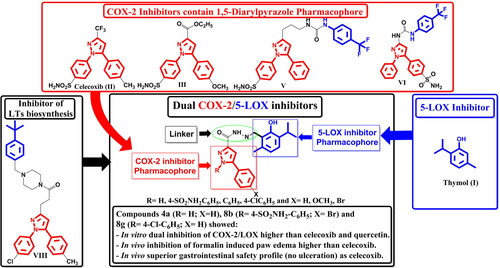Figures & data
Table 1. In vitro COX-1, COX-2, and 5-LOX enzyme inhibitory activities, aIC50 values, and bselectivity indices (SI) of the tested compounds.
Table 2. In vivo anti-inflammatory activities of selected compounds in formalin-induced rat paw oedema bioassay (acute inflammation model).
Figure 7. Mode of binding (2D) of celecoxib (A), 4a (B), 8b (C), and 8g (D) inside the active site of COX-2.

Figure 9. Overlay of compounds 4a (green), 8b (yellow), 8g (pink), and celecoxib (cyan) inside the active site of COX-2.

Figure 10. Mode of binding (3D) of celecoxib (A), 4a (B), 8b (C), and 8g (D) into COX-2 active site.

Figure 11. Mode of binding (2D) of Arachidonic acid (A), 4a (B), 8b (C), and 8g (D) inside the active site of 5-LOX.

Figure 12. Overlay of compounds 4a (green), 8b (yellow), 8g (pink), and arachidonic acid (cyan) inside the active site of 5-LOX.

Figure 13. Mode of binding (3D) of arachidonic acid (A), 4a (B), 8b (C), and 8g (D) inside the active site of 5-LOX.

Table 3. Docking results of the active compounds in COX-2 active site.
Table 4. Docking results of the active compounds in 5-LOX active site.









